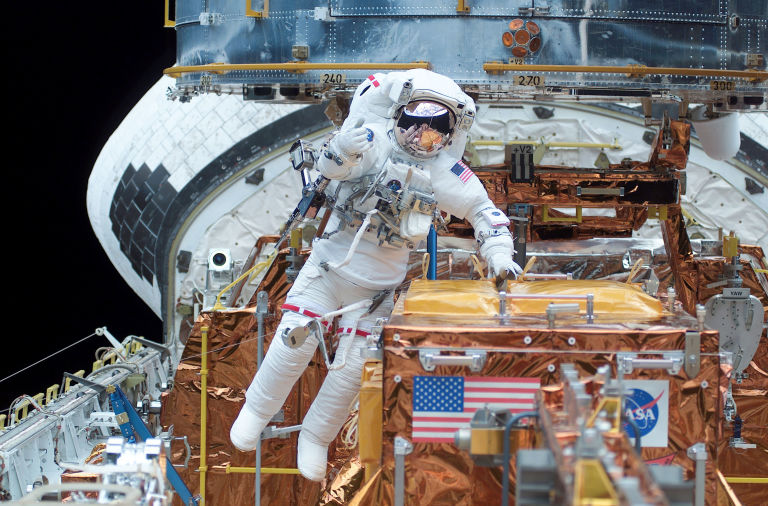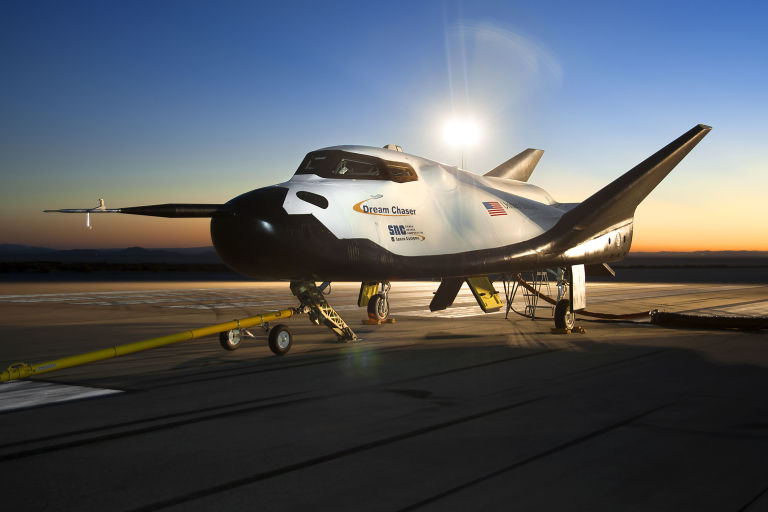Hamartia Antidote
ELITE MEMBER

- Joined
- Nov 17, 2013
- Messages
- 35,188
- Reaction score
- 30
- Country
- Location
http://www.popularmechanics.com/space/telescopes/a25211/mission-to-service-hubble-space-telescope/

Astronaut James H. Newman along the Space Shuttle Columbia's cargo bay with the Hubble Space Telescope in the background during Servicing Mission 3B to install a new instrument, March 5, 2002.
NASA
The Hubble Space Telescope is arguably the most important science instrument ever built—at least in the pursuit of astrophysics—with more than 11,000 research papers written based on over a million observations in its 27-year history. Astronomers around the world vie for the opportunity to point the school bus-sized space telescope at the most intriguing objects in the cosmos. Some of the major fields of research built on Hubble data include early galaxy formation, the rate of the universe's expansion, and the study of black holes.

It might be time for the invaluable telescope to get a tuneup. According to a report from The Wall Street Journal, the Trump Administration is considering a proposal to launch a crewed mission to Hubble to replace sensors, navigation hardware and other aging components. NASA extended Hubble's science operations for an additional five years in 2016, but whether the HST will make it through the 2020s is unclear. A mission such as the one proposed would likely extend the space telescope's operations well into the future.
Sierra Nevada Corporation, the Nevada space services company that put forth the proposal, suggests using its Dream Chaser winged spacecraft for the repair mission. The Dream Chaser is a smaller craft than the Space Shuttle, but similar in overall design. The spaceship is currently undergoing flight tests and development, with a targeted maiden launch in 2019 and the goal of shuttling cargo and science experiments to the ISS shortly after. A Dream Chaser would need to be manufactured with life-support and abort systems to carry astronauts to Hubble, though design plans already exist for a crewed version of the craft.

Outfitting the Hubble with new components would allow the telescope to serve as an "insurance policy" against any malfunctions that might befall the James Webb Space Telescope, a $9 billion project slated for launch in October 2018. As John Wenz at Astronomy Magazine points out, the JWST "will perch itself far from low-Earth orbit (and even beyond the Moon) at a stable point called L2." Sending astronauts out there to fix any problems on James Webb might not be viable at all, and certainly not with current spaceflight technology.
The Hubble Space Telescope has received five servicing missions in the past, all conducted during the Space Shuttle program. The Wall Street Journal report suggests that a sixth mission could achieve many of the goals that the Trump administration has set forth for NASA, including fostering a private-public partnership for space projects and conducting a mission that could be completed with tangible results during the president's first term. That said, the new proposal is in the very early stages of consideration, and approval might not come at all.
Ultimately, the yet-to-be-announced NASA Administrator will have ultimate say over space missions—but the Trump team gets to select NASA's 13th Administrator. If Washington chooses to pursue a Hubble servicing mission, it stands to reason their new head of NASA will make the project a priority.
In addition to serving as a backup for James Webb, the science benefits of keeping the Hubble operational are plentiful. Hubble could provide valuable visual observations to supplement James Webb, which will primarily be imaging the universe in infrared, to learn more about the ancient cosmos then ever possible before. Nothing is set in stone, but it seems a shameful waste not to keep Hubble up and running, photographing the final frontier for decades to come.

Astronaut James H. Newman along the Space Shuttle Columbia's cargo bay with the Hubble Space Telescope in the background during Servicing Mission 3B to install a new instrument, March 5, 2002.
NASA
The Hubble Space Telescope is arguably the most important science instrument ever built—at least in the pursuit of astrophysics—with more than 11,000 research papers written based on over a million observations in its 27-year history. Astronomers around the world vie for the opportunity to point the school bus-sized space telescope at the most intriguing objects in the cosmos. Some of the major fields of research built on Hubble data include early galaxy formation, the rate of the universe's expansion, and the study of black holes.

It might be time for the invaluable telescope to get a tuneup. According to a report from The Wall Street Journal, the Trump Administration is considering a proposal to launch a crewed mission to Hubble to replace sensors, navigation hardware and other aging components. NASA extended Hubble's science operations for an additional five years in 2016, but whether the HST will make it through the 2020s is unclear. A mission such as the one proposed would likely extend the space telescope's operations well into the future.
Sierra Nevada Corporation, the Nevada space services company that put forth the proposal, suggests using its Dream Chaser winged spacecraft for the repair mission. The Dream Chaser is a smaller craft than the Space Shuttle, but similar in overall design. The spaceship is currently undergoing flight tests and development, with a targeted maiden launch in 2019 and the goal of shuttling cargo and science experiments to the ISS shortly after. A Dream Chaser would need to be manufactured with life-support and abort systems to carry astronauts to Hubble, though design plans already exist for a crewed version of the craft.

Outfitting the Hubble with new components would allow the telescope to serve as an "insurance policy" against any malfunctions that might befall the James Webb Space Telescope, a $9 billion project slated for launch in October 2018. As John Wenz at Astronomy Magazine points out, the JWST "will perch itself far from low-Earth orbit (and even beyond the Moon) at a stable point called L2." Sending astronauts out there to fix any problems on James Webb might not be viable at all, and certainly not with current spaceflight technology.
The Hubble Space Telescope has received five servicing missions in the past, all conducted during the Space Shuttle program. The Wall Street Journal report suggests that a sixth mission could achieve many of the goals that the Trump administration has set forth for NASA, including fostering a private-public partnership for space projects and conducting a mission that could be completed with tangible results during the president's first term. That said, the new proposal is in the very early stages of consideration, and approval might not come at all.
Ultimately, the yet-to-be-announced NASA Administrator will have ultimate say over space missions—but the Trump team gets to select NASA's 13th Administrator. If Washington chooses to pursue a Hubble servicing mission, it stands to reason their new head of NASA will make the project a priority.
In addition to serving as a backup for James Webb, the science benefits of keeping the Hubble operational are plentiful. Hubble could provide valuable visual observations to supplement James Webb, which will primarily be imaging the universe in infrared, to learn more about the ancient cosmos then ever possible before. Nothing is set in stone, but it seems a shameful waste not to keep Hubble up and running, photographing the final frontier for decades to come.
